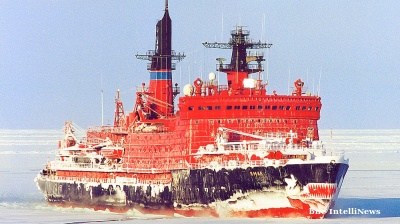ED: This article is one of a series called The Fourth Russia that imagines what the world will be like five years in the future. It is pure speculation based on best-guess assumptions and is designed to be a jumping off point for thinking about what the longer-term consequences of the war in Ukraine will be for Russia, Europe and the world.
The biggest change to the world over the last five years since the war in Ukraine ended is the remaking of the world energy order. While the West re-orientated itself away from Russian oil and gas and Ukraine emerged as a European green energy powerhouse, the Russian energy business was just too deep rooted to tear up completely. Commodity laundering and Russia’s “Crude Cocktails” have proved too lucrative for too many of the non-aligned nations to ignore.
In the first months after Russia’s invasion of Ukraine in February 2022 Europe was adamant that it would block Russia’s oil and gas. Then it tried to do it. While volumes did fall, that was more than compensated by the associated jump in prices.
An attempt to impose a sixth energy package of oil bans was gutted by Russia’s friends in Central Europe and Balkans, which were also afraid of the damage cutting off supplies of hydrocarbons would have on their economies.
In the first years that followed the Kremlin found dozens of ways to dodge the sanctions and willing buyers in the Global South countries that were eager to buy deeply discounted oil, gas and commodities and at the same time curb the Western energy sanctions used to punish Russia – a cudgel they feared would eventually be turned on them.
Sanctions wound but don’t kill
Russia’s oil production fell from a noughties' peak of just over 11mn barrels per day (bpd) to 9mn bpd in the first months of the war before diminishing to 7mn bpd by the end of the year as countries like Germany abandoned Russian oil imports completely.
But since then the volumes produced have slowly recovered to 9mn bpd as five years of heavy investment brings new export capacity online. The main impact of the sanctions has been to force Russia to sell its oil at a 30% discount to the rest of the market, due to its reduced customer base and the risk of secondary sanctions, creating a two-speed market for oil.
The EU tried to wean itself off Russian oil entirely, but only partially succeeded, as too many countries were too dependent on Russian oil and several of them were not prepared to take the pain of replacing cheap and convenient Russia oil with supplies from elsewhere. Brussels' reluctance to pay for Hungary’s retooling of its refineries to process the sweeter blends became a major factor in its decision to refuse to put the sanctions through.
Russia exported 231.6mn tonnes of oil in 2021, and 111.2mn tonnes (49%) went to EU countries plus Norway and the UK, according to the Federal Customs Service. Europe managed to halve the amount in 2022, with Turkey and Hungary taking the lion’s share.
Russian crude cocktails
The passage of the sixth package of sanctions in the summer of 2022 was extremely difficult to pass. Hungary, Bulgaria and Slovakia, all connected to the legacy Druzhba oil pipelines built in the 1970s, refused to end imports of Russian crude for both political and economic reasons. In the end a compromise was thrashed out but despite Brussels' best efforts, Russia continues to export oil to Europe, albeit at reduced volumes.
The argument for cutting off Russian exports to Europe has shifted as the attempts to impose a total oil embargo sent prices soaring at the start of 2024 to briefly break above the all-time high of $147 set in July 2008. Diversification away from Russian oil, but not cutting it off completely, has created a more balanced market that has brought prices down to below $70 a barrel in the last two years and as Russia must sell its oil at a deep discount that has hurt its budget revenues far more than cutting off oil deliveries completely. The Russian budget technically has a break-even price of $42 for a barrel of oil, well below current market rates, but once you factor in the discount, the budget is barely breaking even.
This has also kept countries like Hungary happy, as they can still source cheap oil from Russia also at greatly reduced prices, and it has significantly reduced the cost to Europe of the sanctions.
The sanctions leakage has been significant. Germany joined the direct embargo at the end of 2022 but continued to import Russian oil indirectly for its big refineries near Berlin, buying oil arriving in the Polish port of Gdansk but also availing itself of the so-called “crude cocktails” of oil blends that started appearing on the market. A Latvian blend partly consists of Russian Urals blend and the Kazakh blend mixes Russian and oil from the Kazakh fields which is exported from the Russian port of Novorossiysk on the Black Sea. Shell was caught doing this in the first months of the war when it blended 49% of Russian diesel fuel with 51% of diesel from other origins, giving Russian products the status of “non-Russian origin.”
The cocktail blends have in the meantime become extremely widespread as part of the so-called “commodity laundering.” US officials admit that they are frankly unable to prevent a large part of this business from happening as oil and refined products are shipped around the world as part of the complex international commodities trade. The Russians have already proved they are adept at abusing the international financial system, but they are even better at busting sanctions through “commodity laundering”, as once mixed, it is impossible to tell where a petroleum product originated. Experts estimate Russia has added some 2mn bpd to exports via the schemes.
Russian tankers make ship-to-ship transfers in the middle of the ocean or at friendly ports to create new blends that have sulphur contents that specifically target certain refineries configured to cope with that. Another variant on the cocktail scam has been India’s boosting its imports of Russian crude starting early in 2022, refining it into petroleum products, and then selling those to the US as “made in India.”
Shipping in the crosshairs
The EU also tried to shut down Russia’s access to oil tankers, which mixed results. Russia sent 75% of Russian oil exports to Europe by tanker before the war, but in May 2022 it was completely prohibited by the end of that year.
The sixth package of sanctions threatened secondary sanctions on international shipping firms and insurance companies to prevent Russia sending oil by sea, but the effort was gutted after Greece, which accounts for half the international fleet, successfully lobbied for an exemption. The insurance sanction threat didn't work either, as Russian oil producers were able to get Russian insurance.
Russian exports to Europe via the Druzhba pipeline was exempted as well for Hungary, the Czech Republic, Slovakia and Bulgaria, which collectively accounted for 8% of Russia’s oil exports in 2022, and still do.
The combination of the Druzhba pipeline exports, the use of Russia’s own fleet of ships and the exemptions for Greek shipping meant that Russian exports to Europe fell by only 25% in the first year of sanctions and then to half by the end of 2024.
In the meantime, Russia was working hard to boost exports to new clients. China's share of Russian exports was 31% (71mn tonnes) before the war and is now half. India's share was 1% (1.9mn tonnes) but has risen to 10% in the same period. India’s imports of Russian oil were up nine-fold in just the first three months of the war, albeit from a very low base.
Deliveries to Asia in general have climbed steadily over the last five years from 1mn bpd in 2022 to 3mn bpd now, or a third of Russia’s reduced oil output of 9mn bpd, mitigating much of the EU sanctions impact. The trebling of the ESPO pipeline that runs from Siberia to Asia that is due to come online this year will add another 1mn bpd.
In the last five years Russia has invested very heavily into expanding its fleet of ships by pressing its huge shipyards into service, and has significantly expanded its shipping capacity that covers much of the shortfall while the new eastward bound pipelines are under construction. Another route via Mongolia will be hailed as a “game-changer” by analysts when it comes online in the next few years.
By 2030 Russia’s oil export infrastructure should be fully reoriented to the east, experts say. Over the last five years the continuous expansion of the Northern Sea Route (NRS) due to global warming has led to a boom in the volume of nuclear-powered icebreakers traversing Russia’s northern coast between European Russia and Asia.
Gas still waiting
The story with gas was more complicated, as gas is almost exclusively delivered by pipeline. That makes it harder for Russia to switch delivery to new markets, but it also makes it harder to sanction: gas pipelines are the geopolitical equivalent of marriage and especially when a couple has children (industries and power stations based on gas deliveries), getting divorced is a very messy process.
Russia delivered 155bn cubic metres of gas to Europe in 2021, but the volumes fell noticeably after EU countries began to wean themselves off Russian gas, with Russia cutting off Poland, Finland and the Baltics soon after the war started.
The EU was already in the process of reducing its dependence on Russian gas, since it used to import 80% of its gas from Russia during the Cold War and the share had fallen to some 35% in recent years, although it increased again to around 40% in the first quarter of 2022 due to an exceptionally cold winter and the need to replenish stored gas following the gas crisis in 2021.
Europe had paid Russia just under $100bn by April for gas, but despite pledges to stop the imports it proved impossible to do so, as there was no other fuel source available to replace the Russian gas. Moreover, the storage tanks needed to be replenished before the next winter or Europe would have faced another gas crisis even more extreme than that of 2021 – something the EU managed to do thanks to record levels of LNG imports in the first half of that year.
The end of Russian gas imports was always going to take several years to achieve and even boosted imports of LNG, especially from the US, were never going to be able to replace the Russian gas in the short term.
For Russia’s part, switching the pipeline infrastructure, which all runs west, to the east was an even more formidable task. In the last five years several new projects have been launched, including the Power of Siberia 2, a 3,000-km pipeline that connects Russia’s Yamal gas fields in the Far North to northern China. But negotiations with China over the price of the gas have been tortuous and raising the finance to pay for the $20bn pipeline extremely difficult. Cost overruns and technical problems caused by the ongoing melting of the permafrost have caused significant delays and dramatically raised Gazprom’s maintenance bill, as all its pipelines need upgrading to cope with the melting ground. The Power of Siberia’s completion date of 2030 looks likely to be pushed back again for the third time in four years.
Even when the pipeline is completed, the Chinese offtake volumes are unlikely to be anything like able to replace the European demand. The Power of Siberia 1 delivered 10 bcm of gas to China but that is less than 10% of the EU deliveries and the new pipeline will also likely build up in stages. Adding to the problems is that China does not have a developed domestic gas pipeline network, and this will also have to be built once the supply pipeline is completed. China will eventually replace Europe’s demand. In September Gazprom CEO Alexei Miller predicted that eventually China’s demand for gas will hit 250 bcm – 100 bcm per year more than the EU – but that is not anticipated until 2050.
In the meantime, while deliveries of gas to the EU have fallen by 25%, Europe continues to import significant amounts of gas. Hungary consumed 10 bcm in 2020, down from 14 bcm in 2005, but signed a new long-term contract with Gazprom in 2022, increasing the volumes back to 15 bcm a year, part of which is quietly exported to its neighbours.
Turkey also imports some 30 bcm a year since TurkStream came online in January 2021 and with TurkStream II due to come online this year, that should double to 60 bcm, delivered to Turkey and the Balkan states, as well as further to countries like Italy as “EU gas.”
Other EU states continue to import significant amounts of gas, although half the volumes from the 2022 levels of: Germany (142 bcm), Italy (76 bcm), Slovakia (5.3 bcm), Czechia (8.8 bcm), Serbia (2.5 bcm) and Bulgaria (3 bcm) as the main markets.
While the war was still raging Serbian President Aleksander Vucic signed off on a new three-year gas deal with Russia on May 29 “on very good terms.” That came on top of a similar deal with Hungary that also renewed and expanded its long-term commitment to buy Russian gas in the first months of the war. Moreover, both countries have signed up to take more gas via the new TurkStream southern route that is not subject to sanctions than they need, and have been selling it to their neighbours in what is a significant leakage of the gas sanctions regime.
Altogether Russian exports of gas have fallen considerably since 2022 as the EU heavy investment into renewables eats into gas demand, five years on and Turkey, the Balkans, Hungary, Bulgaria and Czechia still account for 80 bcm per year.
Germany and Italy import reduced amounts of gas but still take some 30 bcm a year for their own use and distribute it across the European pipeline network, serving the base load needs of countries still in the midst of their switch to 100% reliance on renewables as part of the EU’s Green Deal. Like oil, the argument is that importing some gas from Russia keeps the prices down and actually detracts more from the Russian budget than cutting off gas completely would.
Features

Ambition, access and acceleration – Uzbekistan’s Startup Garage opens free academy for entrepreneurship
Aim is to train 50,000 young founders by 2030.

Ukraine’s growing energy crisis promises a cold and dark winter
Since the summer, Kyiv has changed tactics. Given the almost complete failure of Western oil sanctions to curb Russian oil exports, it has been targeting Russian oil refineries. The Kremlin has struck back, targeting Ukraine's power system.

Russia, China sign off on Northern Route shipping deal to slash global freight times
Russia and China have signed a landmark agreement to develop and commercialise the Northern Sea Route (NSR), after Beijing tested the route last month, that could slash Europe-Asia cargo transit times and challenge the primacy of the Suez Canal.

Sri Lanka’s economic escape
Sri Lanka’s recovery over the past year reads like a narrow escape rendered into a cautious, albeit unfinished success story.




_2_1761012864.jpg)